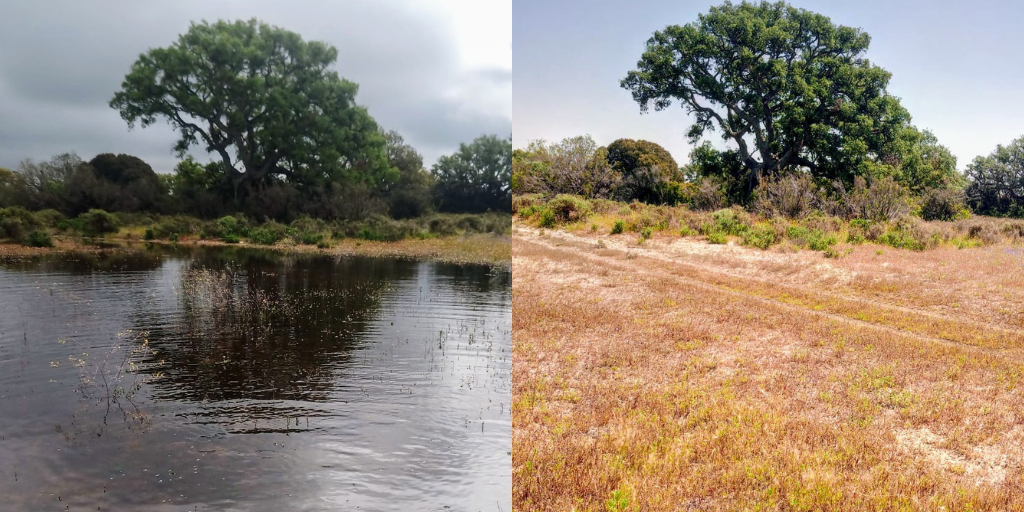Ponds and marshes in Doñana are losing water rapidly due to high temperatures
Rainfall has created an opportunity for waterfowl to breed, but their success will depend on how long water is available

On the left, La Dehesa pond on April 5. On the right, same place, 10 days later // Photos: Rocío Fernández Zamudio, EBD-CSIC.
The recent rainfall has improved Doñana's appearance during this time of year, showcasing flooded marshes and flourishing vegetation like not seen in years. Nevertheless, the delayed rainfalls and increased temperatures are leading to quick evaporation of the water. However, the rains came late and high temperatures are causing the water to evaporate rapidly.
According to data from the ICTS Doñana, depending on the Doñana Biological Station, the Palacio de Doñana reference station recorded 145.3 mm during the last months, making it the second wettest March in the last 50 years. Despite these good numbers, the accumulated precipitation during the hydrological cycle, which extends from September to August, only amounts 404.4 mm, falling short of the historical average annual precipitation, which exceeds 500 mm. This is due to the scarce rainfall during autumn and winter. Rains have come late for the waterbird wintering, causing the lowest numbers in the January census since the research institute started recording it.

Large flooded surface, shallow depth
Rainfall have arrived in time to slighty flood the marshes. It takes about 100 mm of rainfall during the hydrological cycle for the soil clays to become soaked. One they become wet, when it rains, runoff water that circulates through the rivers starts to flood the plain. There is also a part of this water that slowly inflows into the aquifer.
The SIG and Remote Sensing Laboratory of the Doñana Biological Station has analyzed a satellital image taken the 9th of April and has estimated that the current flooded area of the Doñana marsh is 22.053 ha. Considering that the area of natural floodable marshland is about 28,000 ha, it represents 78% of the total area.
Once the marsh is flooded, subsequent rains do not increase the surface area much more, but they do increase the depth of the water layer. This means that, although the flooded area is may be large, the volume of water is not large. In fact, the water at the automatic level station of Honduras del Burro reached a maximum of 38 cm on 9th April, but the water level is dropping since then at a rate of 2.8mm per day. Similarly, Resolimán station reached a maximum level of 42 cm on 3rd April and it is currently dropping 10 mm per day. The data is publicly available at https://datos-automaticos.icts.ebd.csic.es.

Only 1.9% of ponds are flooded
The case of the temporary ponds is more worrying. The ponds are located in sandy areas and mostly depend on the water level of the aquifer. The effects of the rainfall in the aquifer take longer to show since it depends on the natural inflowing system. In addition, recharge levels are linked to the human use of the water: if more water is withdrawn than is recharged by rainfall, the aquifer level continues to fall.
Using information from the satellite image selected, it has been estimated that of the 2811 water bodies that were mapped at a time of maximum flooding, only 56 have some water in them. This is only 1.9% of the total number of ponds. In general, only the larger ponds, such as Santa Olalla, la Dulce or El Hondón, as well as those in the lower areas are currently flooded. This means that only 11.5% of the floodable surface area of the ponds has water.

The rapid evaporation can affect bird breeding
The situation in Doñana is changing rapidly. For many waterfowl species, the recent rains provide an opportunity to breed this year. However, the rapid evaporation of water in the marsh due to high temperatures may mean that there is not enough water to give them time to complete breeding successfully.
For the smaller pond the situation is similar. In some areas, aquatic plants, such as Marsilea strigosa, can already be seen on dry ground, which shows how quickly these water bodies have appeared and disappeared in just a few days. There are some ponds, such as La Dehesa, which were flooded with the March rains and are now dry again. This also has consequences for the breeding of aquatic species such as amphibians. The short duration of the water in these ponds is causing that some species can not complete the larval development.
“We will have to wait to see what happens in the following weeks. In any case, these rains have arrived late for the wintering and are expected to evaporate in summer”, says Javier Bustamante, deputy director of the Doñana Biological Station and responsible of the ICTS-Doñana. “This has alleviated the most immediate drought problems, but many of the water problems in Doñana are deeper and can not be solved with just one good month of rainfall. Rain is needed next fall and winter to this year’s numbers in the wintering season not to be repeated next year”

